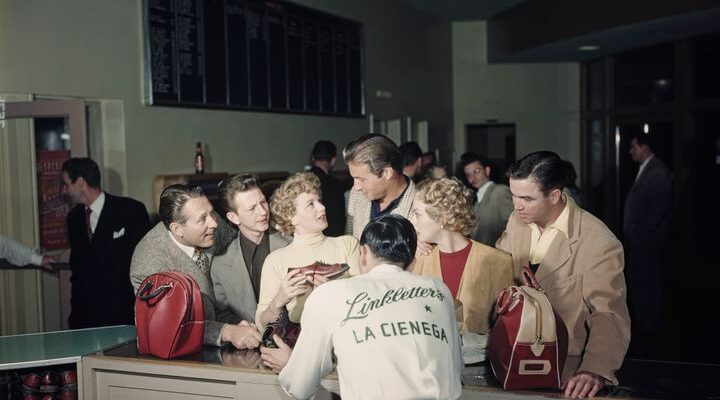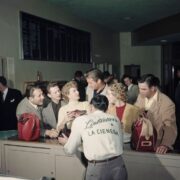Kayla Prowell, a 23-year-old from Philadelphia, Pennsylvania, would really love a place to hang out, and ideally, not have to buy something to do so.
Growing up in the South Suburb of Chicago, Prowell said it felt like there was no shortage of places to come together with friends. That was in part due to local politicians’ and community organizers’ efforts to keep kids off the streets.
“As I kid, I remember going to nature clubs, dance classes, knitting clubs, all after school,” she recalled. “I don’t know if it’s my increasing age or just a natural decline of shared spaces, but now it requires much more effort to find these kinds of spaces.”
“I’ve found myself making concerted efforts in adulthood to join clubs, go on Eventbrite, and more,” she told HuffPost. “I’m an avid QR code scanner if I see a poster for a community event, and I enjoy the YMCA.”
Online communities just don’t cut it anymore, Prowell said. She wants IRL.
“On social media, people are waiting for the confirmation of approval before speaking,” she said, “Take Tinder, for instance, you’re waiting for the match before you interact. It creates a sense of vulnerability to put yourself out there and be perceived and judged by others who you’re just trying to build community with.”
“Americans are spending less time with friends and more time at home alone; time spent at home increased by 1 hour and 39 minutes a day, or 10% from 2003 through 2022.”
Briana Rynée, a 32-year-old writer who lives in St. Louis, Missouri, is in a similar boat. When she’s done with work, she’d love an offline place to hang out that doesn’t have an exorbitant admission fee or hinge on her buying alcohol.
“I’ve started going to bars with pool tables, dart leagues and shuffleboard just to have something to do,” she said. “I’ve even brought board games to bars in an effort to meet people without reaching for liquid courage ― it’s an easy ice breaker.”
Gen Z-ers and millennials like Prowell and Rynée are all too familiar with being Very Online while feeling Very Alone. What they both crave is community and a chance to foster new friendships. What they need is a “third space.”
Coined in the 1980s by urban sociologist Ray Oldenberg, third spaces are places that foster informal, free social interaction. Oldenberg, who died in 2022, argued that such places are essential to democracy and building community.
If our “first” place is home and our “second place” the office, a third space exists outsides those two confines: a place that serves as a hub for socializing and sometimes, personal growth ― for example, community centers, bookstores, parks, a coffee shop, farmer’s markets, art studios, barbershops, public plazas and dog parks all fit the bill.
Though church membership is down nationwide, churches and other places of worship can be considered third spaces, too, since they provide an outsized sense of community: choir practice, cookouts, festivals, Bible study.
In his seminal 2000 book, “Bowling Alone: The Collapse and Revival of American Community,” political scientist Robert D. Putnam hypothesized that Americans had traded their traditional third spaces ― churches, social clubs and the titular bowling leagues — for alone time, to the detriment of society.
In an interview with The New York Times in July, Putman said the message of “Bowling Alone” may be more relevant now than ever: “We’ve become more socially isolated, and we can see it in every facet in our lives,” he said.
Americans are spending less time with friends, and more time at home alone; time spent at home increased by 1 hour and 39 minutes a day, or 10% from 2003 through 2022, according to the Census Bureau’s 2023 American Time Use Survey.
Bert Parry via Getty Images
Disengagement and the disappearance of third spaces have contributed to our loneliness epidemic, a growing crisis which poses health risks as deadly as smoking a dozen cigarettes daily, according to a 2023 report put out by U.S. surgeon general Vivek Murthy.
COVID and the increased blending of home and work spaces made alone time more common, but many of us were already well on our way to becoming hermit-like in our day-to-day lives: A decade ago, we spent more than twice as much time with our friends, an average of 6 1/2 hours a week.
Some, including Sen. Chris Murphy (D-Conn.), believe the loneliness epidemic in the U.S. has helped fuel growing rates of mental illness, substance abuse, violence and even right-wing extremism. (Some studies back that up.)
“I’ve come to the conclusion that there’s a lot of things that unite Americans that we refuse to see, and one of those things is the way that many of us are increasingly feeling very lonely, very isolated and increasingly disconnected,” Murphy told HuffPost last year.
Putnam would seem to agree. As he told the Times in July, “People who are isolated, and especially young men who are isolated, are vulnerable to the appeals of some false community,” he said. “I can cite chapter and verse on this: Eager recruits to the Nazi Party in the 1930s were lonely young German men, and it’s not an accident that the people who are attracted today to white nationalist groups are lonely young white men.”
What counts as a third space — and what doesn’t
You know you’ve stumbled upon a good third space when it’s open to pretty much anyone in the community.
“Third spaces are accessible and tend to be inexpensive or free,” said Richard Kyte, an ethics professor at Viterbo University in Wisconsin, and the author of “Finding Your Third Place: Building Happier Communities (and Making Great Friends Along the Way).”
As Kyte describes it, there’s a “Cheers”-like quality to the best third spaces: It’s a place where everybody knows your name, and they’re always glad you came.
“They’re comfortable, fairly ordinary places where you can just drop in as you are,” Kyte said. “You’re not going there to see and be seen.”
Oldenberg wrote that third spaces are a place for conversation and a space for cultural exchange.
Isabella Segalovich, a writer and artist in South Philadelphia, says the lively, intergenerational conversation is what she and her boyfriend like most about their favorite third space: a local Albanian café where they often grab a bite to eat and work.
“My partner and I are the rare customers who work on laptops here; most people are hanging out, drinking wine with lunch, and chattering in Italian, Albanian, Arabic, and thickly accented Philadelphian English, arguing about politics, the price of house siding and soccer,” she said. “We don’t come in without talking with the owners and cracking a few jokes before settling in.”
In other cases, third spaces are spots where you can be alone together, like the library, one of the few third spaces that reliably still exist in most American communities.
“Libraries are the quintessential third place, because they’re free, they hold ample arts, culture and entertainment,” said Danielle Littman, an assistant professor who studies third spaces at the University of Utah College of Social Work.
“They are one of the only places where you can ‘just be’ without needing to buy something, or prove, literally or symbolically, why you are there,” the professor said.

Southern University and A&M College via Getty Images
What about online third spaces? Subreddits, gaming communities, X or Blusky, closed Facebook groups?
There are some truly identify-affirming spaces online ― Littman points to how liberating and lifesaving forums can be for queer/trans youth in rural areas or in unaccepting households ― but by and large, social media acts more as a bandaid for social interaction and community.
“I think Gen Z may be recognizing the limitations of these spaces in the long term to offer the sustained sense of belonging and connection we all need to survive,” she said.
Despite growing up as digital natives, there’s a hunger for offline life among Gen Zers. Many prefer going to the mall rather than shopping online. After years of chatting about their faves online and fostering parasocial relationships, they’d rather meet in person and host look-alike contests for their favorite celebrities: Fans of Timothée Chalamet, Jeremy Allen White and LA Dodgers baseball player Shohei Ohtani have all held such contests.
Young people obviously aren’t alone in their want for third spaces. Over the past couple of years, Kyte has been traveling around the country talking to people about third places and has found that each generation is hungry for third spaces, but for slightly different reasons.
“Young millennial parents, for example, want to ensure that their children have opportunities for participating in unstructured play with other children and can interact with different generations,” he said.
Older adults and retirees are often lonely because the places they used to go have closed or they have moved to a new community, and don’t know how to get involved, he said.
But the big reason Kyte thinks people are hungry for third places is because technology makes us more independent and less interdependent. We can book travel, shop, be entertained, bank, see a doctor, and exercise all from the privacy of our own home — but at what cost?
“Each year we find ourselves having less social interaction, and we are starting to realize that getting to know people outside of home and work does not just happen on its own,” he said. “We have to be intentional about meeting and talking to others.”

SolStock via Getty Images
Here’s how we can improve the third space scene in the U.S.
Kristen Ghodsee, an anthropologist at the University of Pennsylvania and the author of “Everyday Utopia: What 2,000 Years of Bold Experiments Can Teach Us About the Good Life,” believes we have an anemic culture of third spaces because everything has a cost attached to it.
“In the United States, we’ve commodified people’s desire for third places, and people are more likely to self-segregate into expensive country clubs, gyms, restaurants, bars and clubs, some of which have high membership fees,” she told HuffPost.
The third spaces that do exist aren’t always the most welcoming: For instance, policing of park spaces has arguably limited the access of Black and Brown people to public parks and other greenspaces.
In the context of her work, Littman talks a lot about exclusionary, hostile architecture in the U.S., like window sills with spikes or public parks with high fences, locked gates, and few trees to inhibit park-goers.
“Hostile architecture is a barrier to creating vibrant public third places,” she said. “I think we need to transform our public consciousness around who belongs, and recognize that public means everyone — everyone — belongs. We could do a better job of trusting the public to use third places that do still exist caringly.”
Lyte said zoning laws that cropped up after World War II preventing commercial spaces like bars and cafés from building in residential areas further limit opportunities for third spaces.
One way to figure out a more healthy conception of third spaces is to look to countries who are doing it right, Ghodsee said.
“In Western Europe, where shared public commons are an essential component of any community,” she said. “In eastern Europe, where many large cities were rebuilt after the second world war, research shows that socialist cities have significantly more shared green space than cities rebuilt under capitalism in the west.”
Our cities tend to be built more for cars, but in places with thriving public transportation like Japan, third spaces are cleverly integrated into train stations and urban designs.

Michel Setboun/Corbis via Getty Images
We can also look to people who are carving out makeshift third spaces in unique ways.
“What excites me are the groups and clubs intentionally creating gatherings for their communities,” said Jennifer Pauline, the founder of community-centered creative studio With/Creators in Los Angeles, California. “By focusing on specific interests and groups, they foster deeper and more purposeful connections.”
In Los Angeles, Pauline pointed to physical and pop-up spaces, including Compton Girls Club, a youth girls club; Reparations Club, a bookstore; Plant Chica, a plant shop; and Hike Clerb, an outdoors group.
Ghodsee thinks that the enduring popularity of the annual Pokémon Go fests are also a testament to the appeal of third places for Americans.
“People playing Pokémon Go are inhabiting a virtual reality where the real world becomes a shared third space for all those in the game,” she said.

Bill Tompkins via Getty Images
Even Pickleball has provided a glimmer of hope for researchers who study third spaces.
“It’s the fastest growing sport in America right now, and a big reason for that is it provides a structure for social interaction,” Kyte said. “It also happens to be an intergenerational sport with a lower barrier to entry.”
Littman is excited about the “10-Minute Walk Campaign,” a nationwide movement to ensure that everyone has safe access to a quality park or green space within a 10-minute walk.
We Need Your Support
Already contributed? Log in to hide these messages.
In the wake of the pandemic, Littman sees all these efforts as encouraging signs that Americans are hungry for togetherness after years of going at it alone. “I actually see the pandemic as a huge turning point in many folks recognizing how much we need third places, need community, and need each other.”











Comments